Rounding off this year’s en primeur campaign, Wine Lister’s partner critic platform, JancisRobinson.com has now published its top Burgundy 2020 scores, with further insight into the latest vintage from Jancis Robinson, alongside Matthew Hayes, and fellow Masters of Wine, Andy Howard and Julia Harding.
Explore all Burgundy 2020 scores here, or read more below.
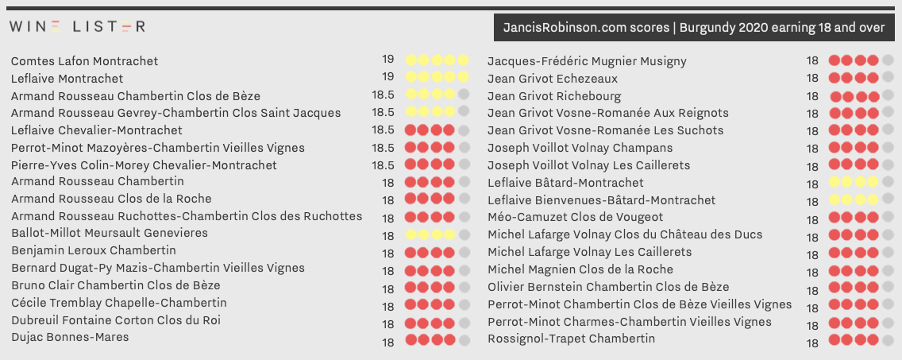
Amongst the 36 Burgundy 2020s that earn 18 and over, five wines receive 18.5 points and two receive a score of 19 – a slight reduction from the number of top scorers in last year’s campaign, with Jancis awarding 18.5 points to 18 Burgundy 2019s and a score of 19 to four wines.
Whites continue to steal the show across this year’s releases, with four receiving a score of 18.5 and above – compared to just one featured within the same parameters last year. Sharing a near-perfect score of 19 are Montrachets from Comtes Lafon and Leflaive – Matthew Haynes describes the former as “honed, dense, and focused”, and the latter as having a “beautiful balance and drive.”
Two producers dominate JancisRobinson.com’s top Côte de Nuits red scores; Armand Rousseau is featured five times in the list, for its Chambertin Clos de Bèze, Gevrey-Chambertin Clos Saint Jacques, Chambertin, Clos de la Roche, and Ruchottes-Chambertin Clos des Ruchottes, and Jean Grivot earns four places, with Richebourg, Echezeaux, Vosne-Romanée Les Suchots, and Vosne-Romanée Aux Reginots all achieving 18 points.
Despite the hot and dry summer causing difficulty to some of the Côte de Beaune reds, four wines from Volnay shine through; Michel Lafarge’s Volnay Les Caillerets and Clos du Château des Ducs, and Joseph Voillot’s Volnay Champans and Les Caillerets.
Discover more Burgundy 2020 scores from Wine Lister’s partner critic, Neal Martin here, an regional specialist, Jasper Morris here.
Insight from Burgundy’s regional specialist
Wine Lister’s partner critic and leading Burgundy expert, Jasper Morris MW completed the release of his Burgundy 2020 scores last week. Below we take a closer look at his top ratings per appellation subset.
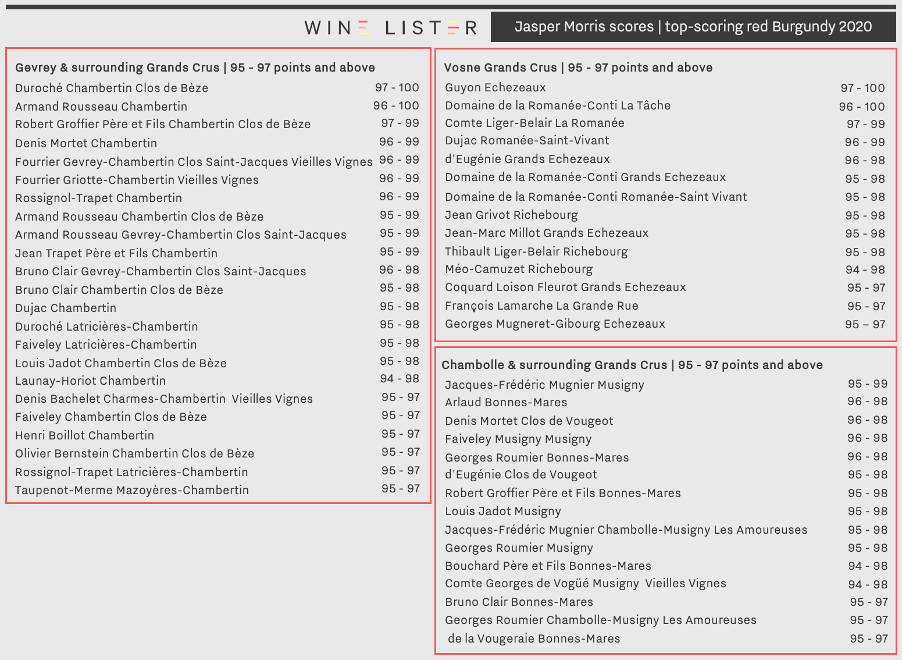
How did Burgundy’s appellations perform in 2020?
Jasper Morris’ Burgundy 2020 report outlines the challenges brought about by such a hot and dry summer, with soaring temperatures throughout August leading to a deficit of juice, particularly in Pinot Noir. The inability of certain rootstock to deal with the hot dry conditions led to the threat of dieback disease (a fungal disease that attacks the trunk, appearing more frequently in stressed vines), with Jasper noting he has “never seen as many vines being ripped out as [he] did in autumn 2020”. Indeed, both factors resulted in relatively low yields for reds, with a number of producers in the Côte de Nuits having “made more wine in the frost-damaged 2021 vintage than they did in 2020.”
Nonetheless, Jasper reported that the hydric stress “concentrated everything, including acidity”, identifying wines with “profound intensity beyond anything [he] saw in 2018 and 2019.” He describes a “universally successful vintage for the white wines”, and a “wider range of styles and successes in the reds”.
Côte de Nuits
With almost all of his top scores given as ranges, much of Jasper’s tasting this year took place whilst wines were still in barrel, as many producers were “tempted to increase the length of élevage for their wines, especially the reds, given the exceptional concentration of the fruit”. This contrasts with the majority of singular scores awarded to the in-bottle samples he rated at the same time last year, and while 2019 did not see any potential 100-point wines, the Côte de Nuits 2020s have five.
The selection includes Duroché’s Chambertin Clos de Bèze and Armand Rousseau’s Chambertin, with the former released as a limited edition cuvée to mark 100 years since the Duroché family planted vines on the site. Also potentially perfect are Guyon’s Echezeaux and Domaine de la Romanée-Conti’s La Tâche, with Jasper suggesting the former “could be THE wine of the vintage.” Completing the line-up is Perrot-Minot’s Richemone Vieilles Vignes, a Premier Cru with a vibrancy that Jasper considers “almost unsurpassed anywhere in the Côte”.
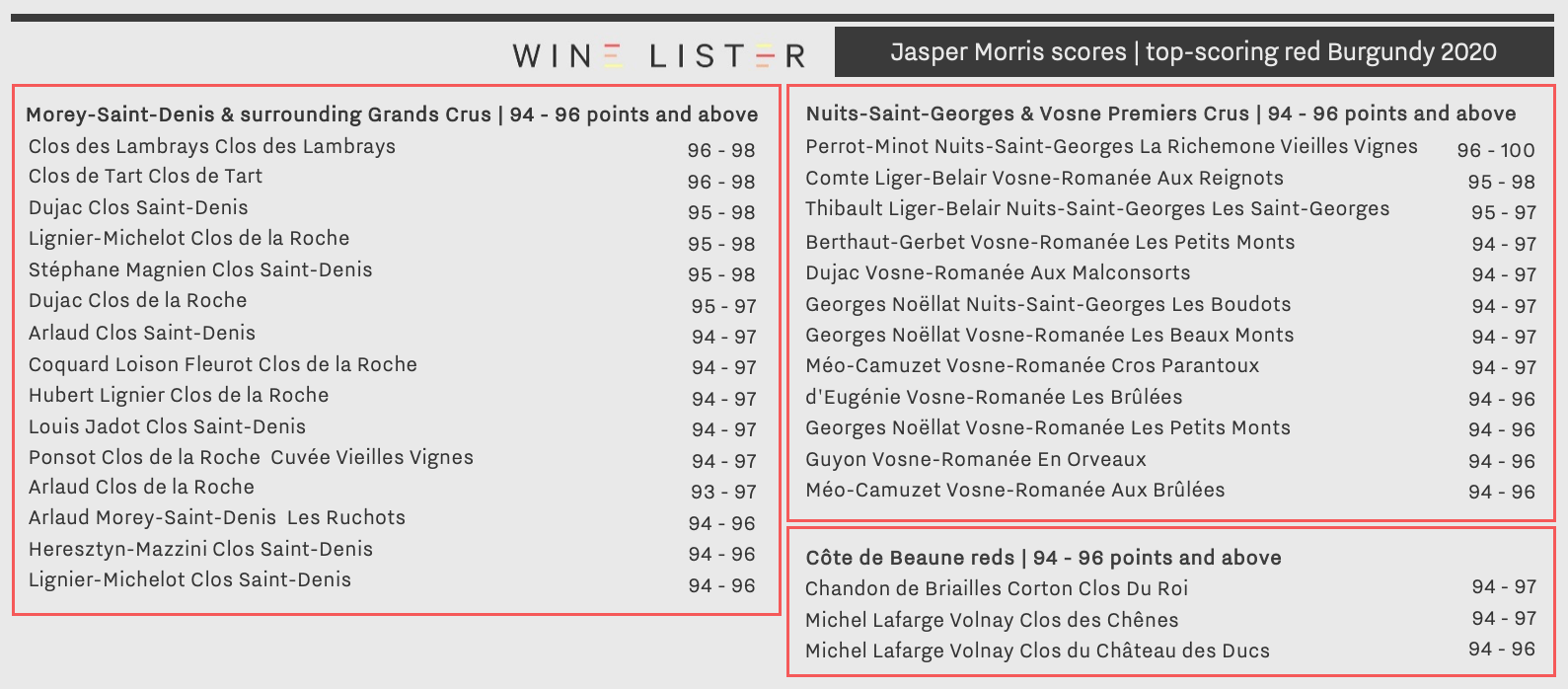
Within Morey-Saint-Denis and its surrounding Grands Crus, Clos de Tart’s namesake cuvée shares the top score for a second year in a row, earning 96 – 98 points, having been complimented for its “spectacular depth”. Clos de Lambrays – nurtured by Clos de Tart’s previous winemaker, Jacques Devauges, since 2019 – matches the rating.
Côte de Beaune – reds
Jasper reports that the most challenging conditions were felt where grapes typically ripen first, including the southern villages of Volnay and Corton. Despite this, several reds including Michel Lafarge’s Volnays Clos des Chênes and Clos du Château des Ducs, and Chandon de Briailles’ Corton Clos du Roi fare well, the latter described as having the “most sensual nose of all”, with notes of “alpine raspberries”.
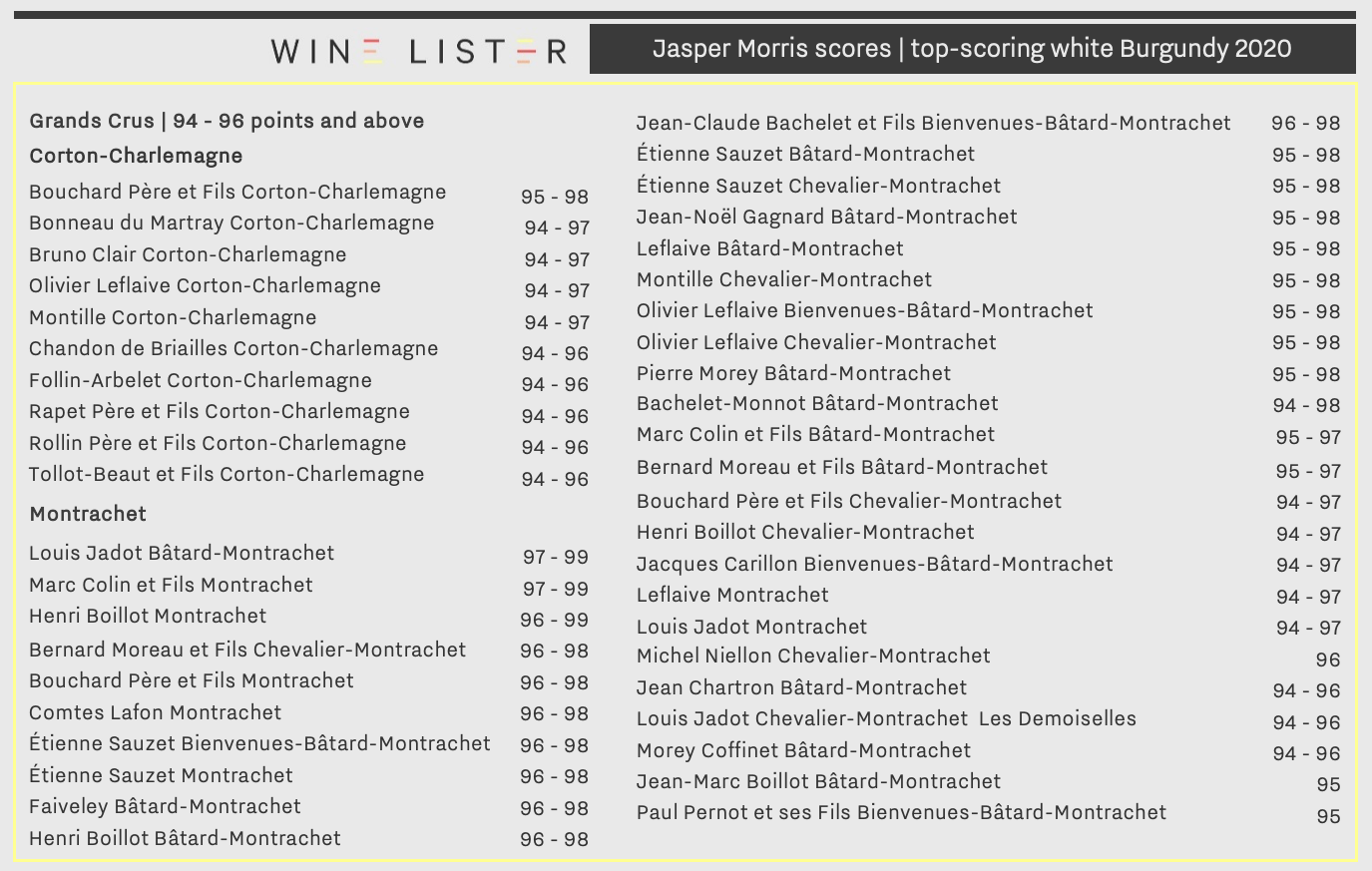
Côte de Beaune – whites
Jasper awards 71 white Burgundy 2020s a score of 94 – 96 and above, compared with last year’s 29 wines scoring 95 and above. He stresses the success of the 2020 vintage across the whites, with Chardonnay grapes retaining more juice than Pinot Noir, and benefitting from a longer ripening time. Montrachet and associated white Grands Crus saw two wines with a potential 99 points – Marc Colin’s Montrachet and Louis Jadot’s Bâtard-Montrachet.
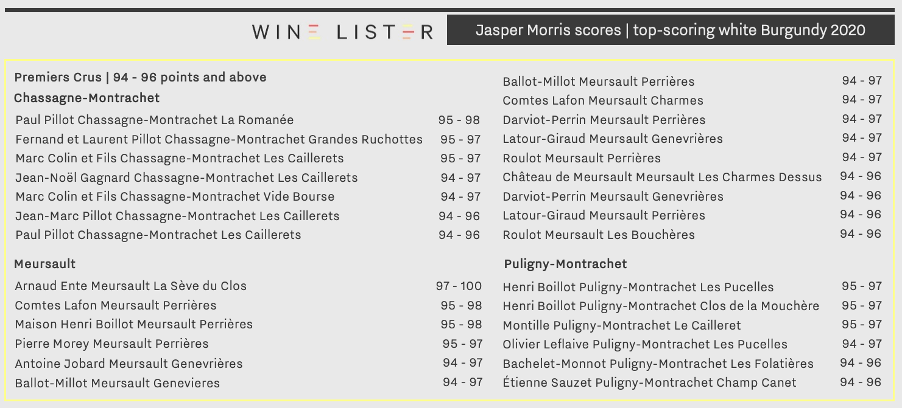
Bouchard Père et Fils’ Corton-Charlemagne achieves a score of 95 – 98, and is praised for expressing “a really impressive wealth of fruit”. Earning the only potential 100-point score for whites in 2020, Arnaud Ente’s Meursault La Sève du Clos was particularly memorable, with Jasper affirming that he has “never seen this consistently great wine as expressive before”.
Explore Jasper Morris’ full Burgundy 2020 report here. For more Burgundy 2020 commentary from our partner critics, recap Neal Martin’s ratings here, and stay tuned for the last lot of scores from Jancis Robinson.com.
The first of Wine Lister’s partner critics to release scores for the latest Burgundy vintage, Neal Martin’s assessment (for Vinous) provides initial insight into some of the top en primeur picks in 2020.
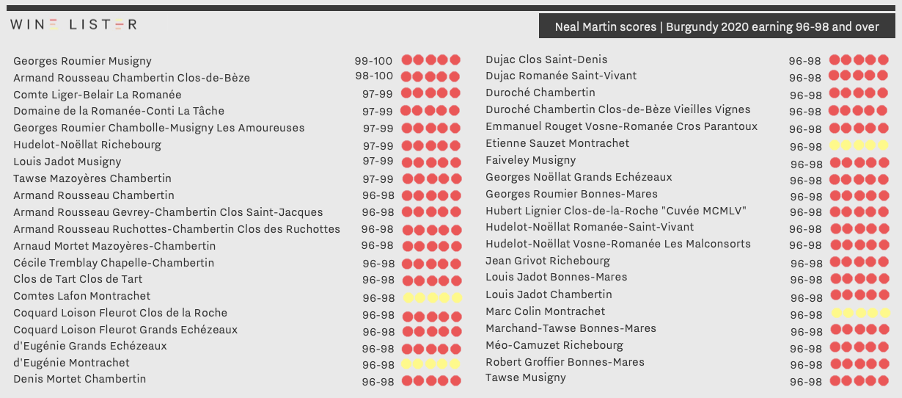
What do we know about Burgundy’s 2020 vintage so far?
2020 will be remembered as a year that saw some of the earliest harvest dates ever recorded in Burgundy, with several of the region’s producers picking as early as 12th August. Though following the pattern of recent vintages marked by warm and dry growing seasons, the threat of drought was partly alleviated by significant rainfall during the winter months through to spring, which ensured water reserves were replenished ahead of the heat. Some Pinot Noir producers nonetheless saw a drop in yields, particularly on sites with poorer soils, and thus restricted water retention ability.
Dry conditions during ripening minimised the threat of disease and mildew, which was valuable for the healthy growth of red and white grapes. Despite the earlier harvest, the grapes saw excellent ripening and phenolic development, while high levels of evaporation concentrated sugars, flavours, and acidity.
The top-scorers
Compared to the 19 wines that Neal Martin awarded 96-98 and above last year, there are an impressive 40 wines within the same parameter for the 2020 vintage. While there were no wines that earned a potential perfect score in 2019, Georges Roumier’s Musigny and Armand Rousseau’s Chambertin Clos-de-Bèze receive 99-100 and 98-100 points respectively in 2020. Neal Martin notes that the top-scoring reds of the vintage all share an excellent acidity, which “lends the 2020s a sense of brightness”.
Also faring notably well, Comte Liger-Belair’s La Romanée, Domaine de la Romanée-Conti’s La Tâche, Georges Roumier’s Chambolle-Musigny Les Amoureuses, Hudelot-Noëllat’s Richebourg, Louis Jadot’s Musigny, and Tawse’s Mazoyères Chambertin earn scores of 97-99.
Whites worth trying
Four whites hailing from Montrachet appear on the list, with offerings from Comtes Lafon, Domaine d’Eugénie, Etienne Sauzet, and Marc Colin each earning a score of 96-98. Neal Martin describes mineral notes across each, having written that this was one of the great attributes of the top whites in the vintage – especially across those grown on more “calcareous soils” akin to that which Montrachet boasts. Following the trend of white burgundy producers using less new oak, Marc Colin uses only old oak barrels for the first time in this vintage, while Comtes Lafon matured Montrachet in one-third new oak instead of 100%.
Discover Neal Martin’s full list of Burgundy 2020 scores here. Watch this space for further Burgundy 2020 score updates from Wine Lister’s partner critics, JancisRobinson.com, and specialist Burgundy critic, Jasper Morris MW.
Eager to get a full picture of the 2018 vintage, the Wine Lister team immersed itself in London’s Burgundy week last week, attending eight tastings between us. Having been spoilt by a handful of tastings in the cellars of top domaines in July and December 2019, we braced ourselves for a reality check in the light of the challenging growing season.
Burgundy was baking hot in the summer of 2018, with the highest amount of sunlight for half a century, according to Olivier Lamy of Domaine Hubert Lamy. Making great wine in this vintage was all about the producers’ choices, and great wines there are, but not across the board. Key decisions included production volumes (not too high, or too low!), picking dates (early, or at least not too late), and canopy management (or rather lack thereof, letting the leaves protect the grapes from too much sunlight).
The 2018 vintage has been touted as one of quality and quantity. White wine volumes were indeed high, and this arguably helped avoid over-ripeness (though too much volume risked dilute flavours). However, red quantities are not always more generous than average in 2018, with many producers managing yields with green harvesting. As for picking dates, August start dates were more commonplace than ever before. Picking in time was crucial – throughout our tastings, the Wine Lister team found that occasional wines showed signs of fruit left hanging a day or two too long. However, no blanket rule applies, and producers such as Grivot, who waited until mid-September, made some of the finest wines of the vintage.
It was clear early on that a hot summer was potentially in store, so arguably an easy call to leave a sufficient amount of foliage to protect the grapes from the relentless sun. More producers are following in the footsteps of Lalou Bize-Leroy and forgoing trimming altogether. For example, Charles Lachaux of Arnoux-Lachaux has been experimenting with making arches of his vines, which necessarily creates more shade.
 Pictured: Charles Lachaux says when building his vines into arches, “there’s only one rule: there are no rules”.
Pictured: Charles Lachaux says when building his vines into arches, “there’s only one rule: there are no rules”.
In some cases the sunshine overwhelmed, but in many more, savvy producers – used to making wine in the context of global warming by now – managed the conditions deftly. Romain Taupenot of Domaine Taupenot-Merme has observed that even the soils have learned to adapt to warmer conditions over time, regaining acidity more quickly than in hot vintages of the past, such as 2003.
The 2018 Burgundy vintage is heterogenous, but we were surprised by how few wines were negatively marked by the extreme conditions of the vintage. The majority of wines manage to harness good acidity and lightness of touch, if not the intense freshness and succulence of 2017. However, the words “limpid”, “bright”, and “lifted” appear far more often in my tasting notes than “rich”, “ripe”, or “heavy”.
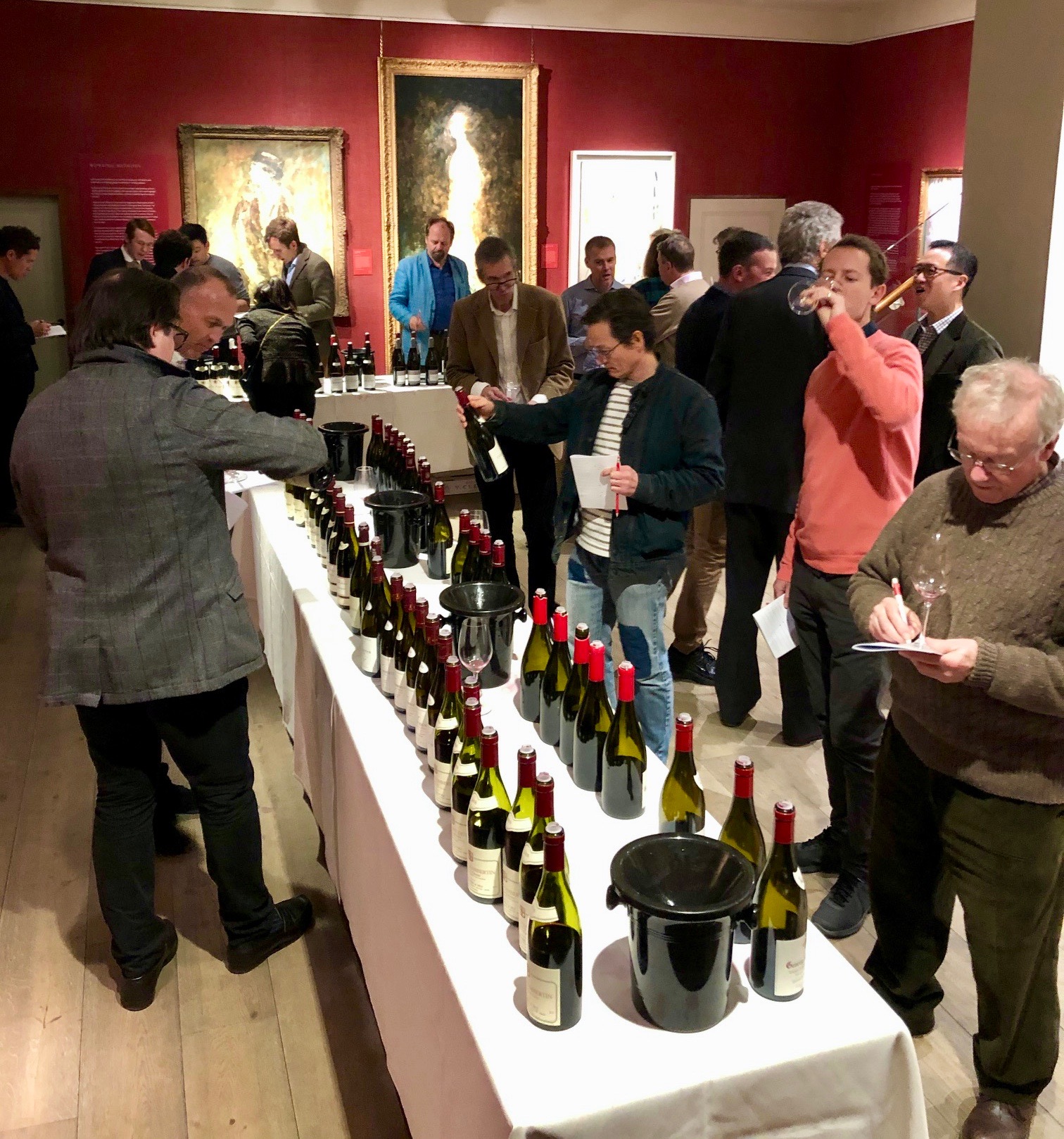 Kicking off Burgundy week tastings with Goedhuis at the Philip Mould Gallery, featuring producers such as Tortochot, Domaine de l’Arlot, Benjamin Leroux, and Jean-Marc & Thomas Bouley to name but a few.
Kicking off Burgundy week tastings with Goedhuis at the Philip Mould Gallery, featuring producers such as Tortochot, Domaine de l’Arlot, Benjamin Leroux, and Jean-Marc & Thomas Bouley to name but a few.
If pushed to choose, this is a red vintage, with higher heights than for whites, which are more consistent but less often exciting, though absolutely not to be ignored. The best reds have harnessed all the energy, vibrancy and texture of the long, hot summer, without being overly sweet or jammy.
After tasting hundreds of wines last week, there are no obvious standout appellations, but rather standout producers. That does not mean that appellations did not stand out – many producers were able to translate terroir impressively given the strong imprint the vintage tried to leave. The wines of Bruno Clair for example, let the different vineyards sing, with a Chambolle “de chez Chambolle” and a very “Vosne” Vosne-Romanée Les Champs Perdrix.
Watch this space for our recommendations, coming soon.
Towards the lower end of the Domaine de la Romanée-Conti spectrum is its Corton. The 2015 vintage was released this morning at £275 per bottle. Below we look at all the facts:
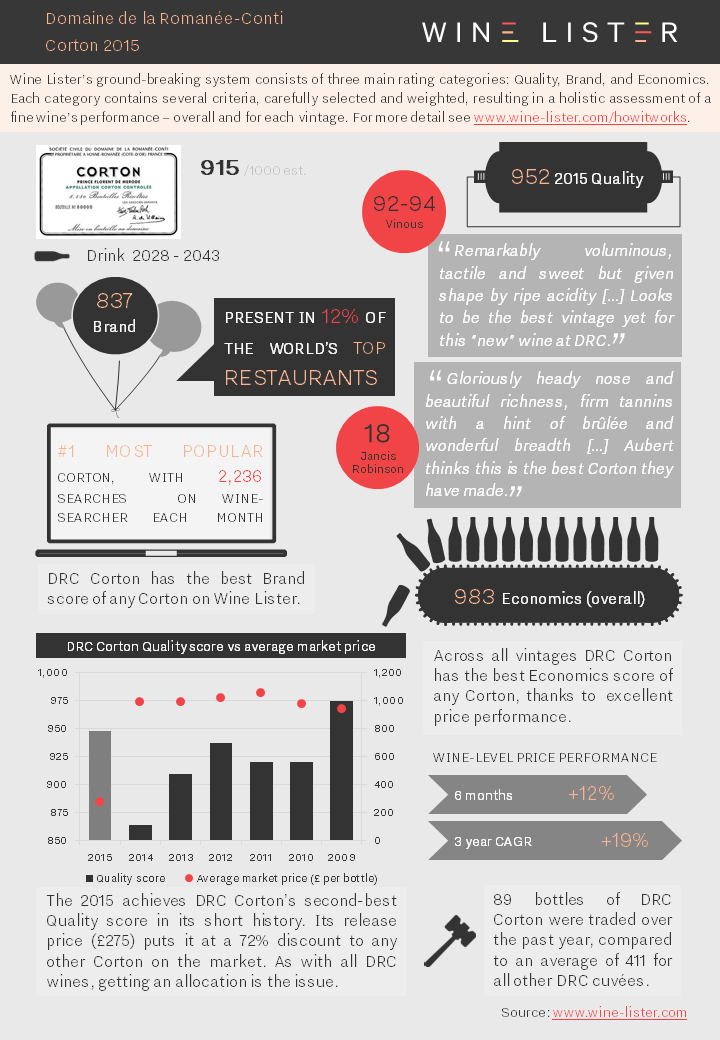
You can download the slide here: Wine Lister Fact Sheet DRC Corton 2015
Domaine de la Romanée-Conti has released its 2015 prices this morning. Below we summarise key points of its La Tâche 2015, UK RRP of £1000 per bottle.
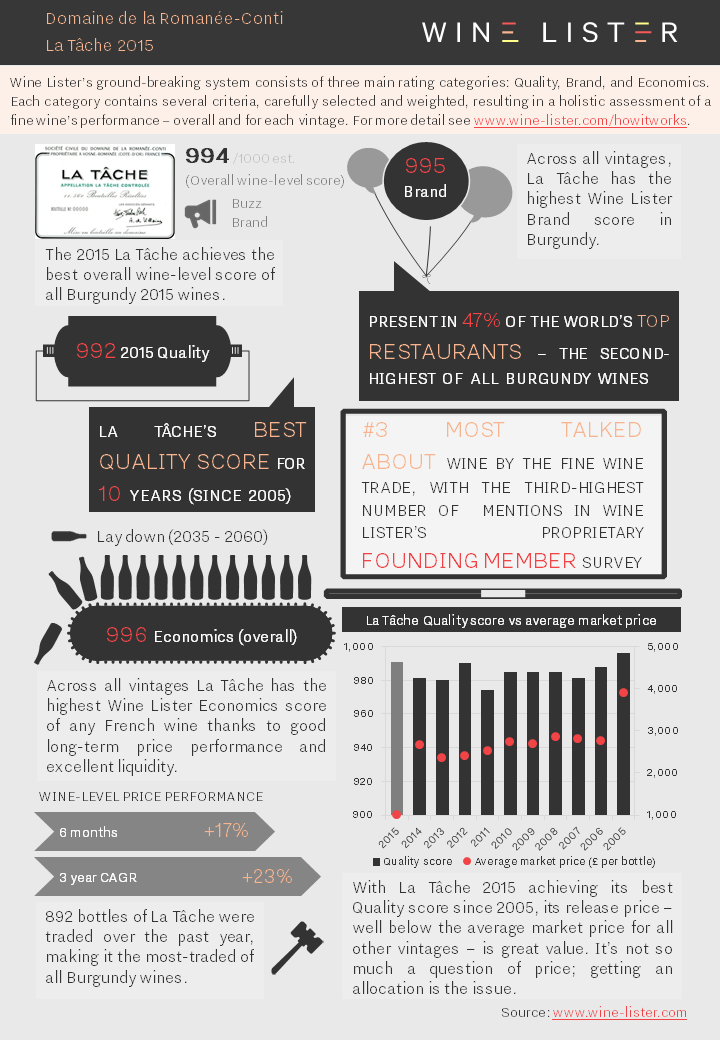
You can download this slide here: Wine Lister Fact Sheet DRC La Tache 2015






 Pictured: Charles Lachaux says when building his vines into arches, “there’s only one rule: there are no rules”.
Pictured: Charles Lachaux says when building his vines into arches, “there’s only one rule: there are no rules”. Kicking off Burgundy week tastings with Goedhuis at the Philip Mould Gallery, featuring producers such as Tortochot, Domaine de l’Arlot, Benjamin Leroux, and Jean-Marc & Thomas Bouley to name but a few.
Kicking off Burgundy week tastings with Goedhuis at the Philip Mould Gallery, featuring producers such as Tortochot, Domaine de l’Arlot, Benjamin Leroux, and Jean-Marc & Thomas Bouley to name but a few.
